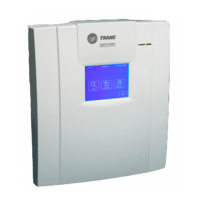Chapter 5 UCM Wiring and Addressing
138 BMTW-SVN01F-EN
Wiring Notes
To establish wiring connections between the UCM and the BCU, Trane
requires that you use the communication-link wiring specified in this
manual. For wire selection specifications, see “UCM Communication-
Wire Characteristics” on page 55.
Use fiber-optic modems for building-to-building communication. If fiber
optics are not used, building-to-building communication wiring requires a
Transtector transient protector at each building. You can purchase Tran-
stector protectors through Trane. Contact your local Trane sales office for
details.
In a daisy chain configuration, use one pair of wires that start at the BCU
and go to all UCMs in a continuous loop. A branch configuration is possi-
ble if you need to tap into a daisy chain. Limit the total aggregate length
of the wiring for each communication link to 5,000 ft (1,524 m).
To connect communication wiring:
1. Attach one end of the communication-link wiring to TB2 on the BCU.
For the location of TB2, refer to Figure 16 on page 47.
2. Attach the other end of the communication-link wiring to the Voyager
UCM at the TB2-(+) and TB2-(-) terminals on the TC2-3 board as
shown in Figure 63 on page 137.
To connect shield:
1. Connect the shield at the BCU (TB2) to provide a drain for RFI/EMI,
and then splice it with other Voyager rooftops shields at the Voyager
rooftop end.
2. Tape the shield at the last Voyager rooftop in the chain to prevent
any connection between the shield and ground (see Figure 64 on
page 139).
IMPORTANT
UCM ground loops will cause a malfunction.
Note:
Observe the polarity throughout communication links.

